Highlights from the 24th Annual History Conference at Luzerne County Community College
Written by Tony Mussari, Sr.
Edited by Kitch Loftus-Mussari
Photographs by Kitch Loftus-Mussari
Copyright Mussari-Loftus Associates, LTD 2015
All Rights Reserved
You can’t be a full participant in our democracy if you don’t know our history. David McCullough
Our Face of America journey took us to the Conference Center at Luzerne County Community College on October 9, to screen  Four Days of Honor and Valor in Gettysburg and to learn about “Caring for Veterans in Northeastern Pennsylvania.” Little did we know when we arrived how poignant and powerful the sessions of the 24th Annual History Conference would be.
Four Days of Honor and Valor in Gettysburg and to learn about “Caring for Veterans in Northeastern Pennsylvania.” Little did we know when we arrived how poignant and powerful the sessions of the 24th Annual History Conference would be.
After he graciously saluted the veterans who were sitting in the audience and the faculty and staff who organized the event, Dr. Thomas P. Leary, President of Luzerne County Community College, caught everyone by surprise with his candid admission that the community college is not doing enough to acclimate veterans to the educational opportunities that are available at the school.
He thanked the veterans whose experience, perspective and wisdom enrich the classroom experience. He promised to create more opportunities for veterans to share their experiences in meaningful ways, and he promised that he and the members of his team would do more to streamline the admissions process for veterans.
Mark J. Riccetti, Jr., Director of Operations for the Luzerne County Historical Society, a co-sponsor the conference, reinforced Dr. Leary’s comments with ten words:
“This is probably the most important topic we have ever done.”
Context
John Shalanski is a licensed clinical social worker. Because of  his extensive experience, he was invited to deliver the keynote address, “Caring for Our Wounded Warriors: An Historical Overview.”
his extensive experience, he was invited to deliver the keynote address, “Caring for Our Wounded Warriors: An Historical Overview.”
He told the audience that 1,000 veterans are diagnosed with PTSD every week, and 800 veterans are diagnosed with depression. Then he asked this question:
Historically, how have we treated our returning veterans?
Before he traced the history of this issue from the Revolutionary War to the present, he made his position very clear. We have a responsibility to give our veterans the best care, and history teaches us that we have not always lived up to that challenge.
Dr. Shalanski is not a wounded warrior, but his father, a World War 11 veteran, is his hero. His relationship with his father enabled him to better understand the complexity of the problems facing returning veterans, and their need for compassionate and competent care.
These are a few of the insightful comments presented by Dr. Shalanski:
1. We need to listen to our Wounded Warriors with humility and 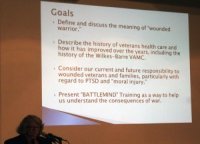 respect;
respect;
2. We need to decompartmentalize the care and services available to them;
3. We must debunk the myths that reinforce the code of individualism that stereotype returning veterans in a negative light;
4. The horrendous experience of war for our returning veterans produces much more than exhaustion, shell shock, and combat fatigue;
5. Our veterans come home with moral injuries first described after the Civil War as Soldier’s Heart;
6. Our veterans return with “Moral Injuries” that can best be described as “bruises on the soul.”
Dr. Shalanski’s presentation was designed to present an accurate record of the past in an attempt to humanize the suffering of the 2,000,000 veterans who have gone to war since September 11, 2001.
He summarized the main point of his remarks with these words:
“We can do better. We have to do better.”
Perspective and Reality
When Dr. Bill Kashatus introduced Mark Kohn’s presentation,  he made a comment that caught everyone’s attention:
he made a comment that caught everyone’s attention:
620,000 soldiers died during the Civil War. For every soldier who served, there was a 25 per cent chance of not surviving the war.
Mark Kohn picked up on that statistic with an equally gruesome number:
Of the 620,000 soldiers who died during the Civil War, two-thirds died from diseases like dysentery, typhoid fever, malaria, scurvy, pneumonia and tuberculosis to name but a few.
More than 413, 000 deaths were caused by poor hygiene, overcrowding, bugs, and contaminated water.
Kohn skillfully showed the audience all of the tools of the trade for Civil War physicians. Doctors relied heavily on opium, morphine and mercury to treat injured soldiers.
The field surgeon’s kit contained chloroform for the patient and Old Crow for the doctor. The whisky enabled the doctor to survive the 45-48 operations each day! Yes, some doctors were inebriated when they were treating patients.
At one point in his presentation, Kohn asked a student to join him as he demonstrated how a procedure would have been done in a Civil War hospital. Without question, this was the high point of his session. It was graphic, but realistic. By contemporary standards, it was primitive and dangerous.
War hospital. Without question, this was the high point of his session. It was graphic, but realistic. By contemporary standards, it was primitive and dangerous.
At another point, Janis Wilson Seeley, the chairperson of the history department, joined Kohn in the front of the room to help him demonstrate how blockade runners smuggled medicine to Confederate doctors.
During his session, Mark Kohn shared several interesting points about military health care.
1. He debunked the “Bite the bullet Myth.”
2. Of the 30,000 amputations on the Union side, 75 per cent of the patients survived.
3. Because the Confederate doctors used boiled horse hair to bind wounds, they had fewer deaths from operations.
4. Unable to cope with the horrific conditions, there were doctors who committed suicide.
5. Before 1863 all nurses were male. Dorothy Dix and Clara Barton disproved the myth that women would not be able to endure the graphic conditions of field hospitals.
6. In many ways, the beginning of modern medicine began after the Civil War in the 1890s.
Looking backward at the conditions wounded warriors faced during the Civil War and after reminded me of something Rudyard Kipling said a long time ago:
“If history were taught in the form of stories, it would never be forgotten.”
Current Health Care for Our Wounded Warriors
The final event of the conference featured four members of a panel 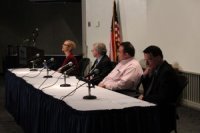 discussion: Atty. Siobhan Fuller McConnell, Kevin Ferris, Alberto Morales, and James Shovlin.
discussion: Atty. Siobhan Fuller McConnell, Kevin Ferris, Alberto Morales, and James Shovlin.
James Shovlin is the Coordinator of Veterans’ Education at LCC. He talked about the services available at the community college. He was quick to point out that veterans bring a strong work ethic, discipline and a willingness to serve others to the classroom. They are great role models for young students.
In response to a question about life lessons he has learned working with veterans, he shared this thought:
Veterans have to deal with problems for their whole life so try to be there for them for the long haul and let them know that you will be there for them.
Alberto Morales is a counselor at the Wilkes-Barre Veterans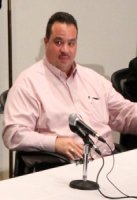 Hospital. He was born and raised on the mean streets of New York. He served in the Gulf War, and when he came home he wanted to continue his service to others.
Hospital. He was born and raised on the mean streets of New York. He served in the Gulf War, and when he came home he wanted to continue his service to others.
He made the necessary sacrifices to get an education, and today he has a job that requires that he be on call 24 hours a day. He is the only suicide prevention coordinator in the country that does this.
Morales believes that it takes family, friends and the community to save a life. It’s a difficult job and it takes a sense of humor to do it effectively.
Kevin Ferris is an Editor of the editorial page of The 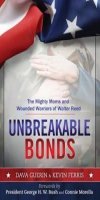 Philadelphia Inquirer. Dava Guerin and Kevin co-authored “Unbreakable Bonds: The Mighty Moms and Wounded Warriors of Walter Reed.”
Philadelphia Inquirer. Dava Guerin and Kevin co-authored “Unbreakable Bonds: The Mighty Moms and Wounded Warriors of Walter Reed.”
Kevin introduced the audience to 10 veterans and 10 mighty moms. These 20 people come from all over the country. They have two things in common. They know in very real ways the challenges wounded warriors and their parents face. They know the services provided at Walter Reed Army Hospital in Washington, D.C.
The mothers have another thing in common. They were not prepared to deal with their wounded child.
Atty. Siobhan Fuller McConnell is the mother of a wounded warrior. Without question, she provided the most compelling and poignant story of the day.
In 2011, she had two sons in the military. On July 23, 2011, she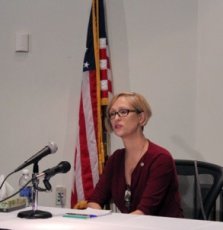 received a telephone call that changed her life forever. Her oldest son Derek was injured in Afghanistan. For several weeks the details of his injuries were sketchy. When she met him at Walter Reed, he had lost both of his legs. He had a fractured skull and a fractured jaw. His right arm was badly injured.
received a telephone call that changed her life forever. Her oldest son Derek was injured in Afghanistan. For several weeks the details of his injuries were sketchy. When she met him at Walter Reed, he had lost both of his legs. He had a fractured skull and a fractured jaw. His right arm was badly injured.
Derek spent 53 days in ICU. He had 36 medical procedures.
While caring for her son, Siobhan lost her job.
In March 2013, Derek was readmitted to the hospital with severe pain. One evening his body went into shock, and he never woke up.
There is much more to Siobhan and Derek’s story. A detailed account is available in ’ “Unbreakable Bonds.”
When I asked Siobhan what life lessons she learned from her experience. She did not hesitate to respond.
“Keep a sense of humor. Everyday laugh or smile about something. Always look for light and something to get out of bed for.”
In my opinion, Atty. Siobhan Fuller McConnell is a classic example of the Face of America at its very best. Her mission to tell her story and enlighten all of us about the needs of our wounded warriors personifies the beautiful message Stephen E. Ambrose shared with us when he defined history with these words:
The past is a source of knowledge, and the future is a source of hope. Love of the past implies faith in the future.
Before the conference came to a close, Dr. Bill Kashatus  summarized the most important lessons learned during the sessions:
summarized the most important lessons learned during the sessions:
1. Dr. John Shalanski took us on a journey that expanded our view. He effectively made the case that woundedness is more than physical. It is psychological, moral, and emotional;
2. Mark Kohn provided a graphic picture of healthcare during the Civil War. In so doing he made a case for competent, compassionate and humane treatment for veterans;
3. Four Days of Honor and Valor in Gettysburg presents inspirational models of integrity, humility and selfless service;
4. The members of the panel shared compelling stories that prove there is a lot of work that needs to be done to help our Wounded Warriors;
5. We need to find effective ways to thank our veterans for their service and sacrifice.
The 24th Annual History Conference was a day of learning, thinking and growing in compassion for those who risked their lives for our country.
It was a reminder of the past and a blueprint for the future.
An adaptation of the words of T.H.White applies
Learning is the only thing which the mind can never exhaust, never alienate, never be tortured by, never fear or distrust, and never dream of regretting.
Thank you, Luzerne County Community College for hosting the event.
Thank you, Luzerne County Historical Society for co-sponsoring the conference.
Thank you, Luzerne County Community College Food Service Department. Lunch was excellent.
Thank you, Luzerne Community College support people for all that you did to make everyone feel welcome.
Thank you Matt Hall and Matt Popecki of PCNTV for the courteous and professional way you recorded the conference.
Thank you, Dr.Bill Kashatus for continuing this wonderful tradition.
Please provide feedback to:
tony.mussari@gmail.com